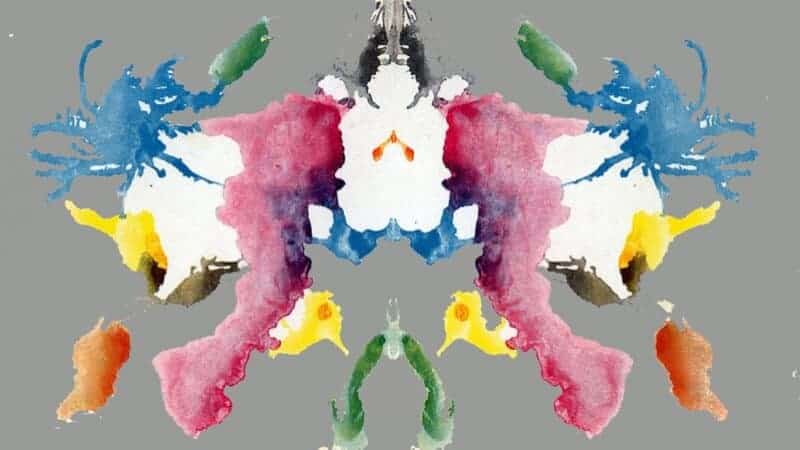Animal hides, bats, humans, lobsters, rabbit heads and a lot of other things have been seen in Rorschach inkblots, but none were deliberately placed there.
They are, according to UO physicist Richard Taylor, perceptions triggered by fractal characteristics of varying dimensions that trick our visual system. Fractals are objects with irregular curves or shapes — think trees, clouds, rivers, galaxies, lungs and neurons. They are recognizable building blocks of nature.
Taylor’s interest in the inkblots, once a standard psychological tool, relates to his work to develop fractal-based retinal implants to restore vision.
“These optical illusions, seen in inkblots and sometimes in art, are important for understanding the human visual system,” said Taylor, who is director of the UO Materials Science Institute. “You learn important things from when our eyes get fooled. Fractal patterns in the inkblots are confusing the visual system. Why do you detect a bat or a butterfly when they were never there?”
Fractal-based materials also could make for more effective camouflage. Imagine, he said, soldiers’ perceiving a hippopotamus on a hillside when what’s really there is the enemy coming right at you?
In a paper published Feb. 14 in the journal PLOS ONE, Taylor, a professor in the Department of Physics, and colleagues from five institutions presented the findings of their study of the 10 Rorschach inkblots. Image associations on the inkblots — some 300 for each one have been reported — are induced by fractal characteristics at the edges of the blots and depend on the scaling parameters of the patterns, Taylor’s team found.
To make the inkblots, Swiss Freudian psychiatrist Hermann Rorschach just poured different amounts and kinds of ink onto separate cards, folded them and pressed them tightly before opening them to display symmetrical patterns of varying complexities.
Rorschach published 10 of his inkblot patterns, five in black and white and five in color, in 1921. He died in 1922, never knowing of their subsequent widespread use. In the last 20 years, that use has declined because of controversy over whether people’s perceptions really do speak to mental health or reflect a person’s level of creativity or past experiences.
Taylor and colleagues analyzed the boundaries of the inkblots on each card. After scanning the cards, they used an edge-detection computer analysis, using a parameter called fractal dimension D, to help them define the boundary complexity. Combining this analysis with original psychology studies done on the blots in the 1930s and 1950s, the researchers found a clear trend.
AUDIO: Richard Taylor summarizes the key finding and its potential importance
“As you increase the D value, which makes for more visual complexity, the number of visual perceptions fall off,” he said. “People see a lot more patterns in the simple ones.”
 Inkblots with values of 1.1 generate the highest numbers of perceived images, the team found. As D values increase, fractal edges lose their irregular shapes, becoming more smoothly rounded, and visual perceptions decline.
Inkblots with values of 1.1 generate the highest numbers of perceived images, the team found. As D values increase, fractal edges lose their irregular shapes, becoming more smoothly rounded, and visual perceptions decline.
The team next put their findings to a human test, generating computerized fractal patterns with varying D values. When seen for 10 seconds by undergraduate psychology students at the University of New South Wales in Australia, the same trend surfaced.
Fractal patterns are found in the artwork of Jackson Pollock, whose abstract expressionist paintings captured Taylor’s lifelong interest from childhood. Pollock’s paintings from 1943 to 1952, Taylor has found, are composed of fractals with D values that increased from 1.1 to 1.7. That change was deliberate, Taylor said, as Pollock sought ways to reduce such imagery seen in his earlier work.
The new study is among many that Taylor and his colleagues have pursued to better understand the connection between vision and nature.
“All of our studies are highlighting an effect called fractal fluency,” he said. “The eye has evolved to efficiently process the fractal patterns found in nature’s scenery. This reduces the observer’s stress by up to 60 percent. If you don’t build fractal fluency into a bionic eye, not only have you lost the ability to navigate, you’ve also lost that symbiotic relationship with nature’s fractal patterns.”
Using D values in conjunction with the eye’s natural fractal detector for retinal implants or camouflage, Taylor said, could be compared to fine-tuning a radio: “First thing is, here’s some music coming through. Step number two allows you to tune it so much that you can actually appreciate the aesthetics of the music.”
Taylor shares a U.S. patent that covers all fractal designed electronic implants that link signaling activity with nerves for any purpose in animal and human biology. In January 2016 he received a $900,000 grant from the W.M. Keck Foundation to pursue his work on fractal-based retinal implants.


